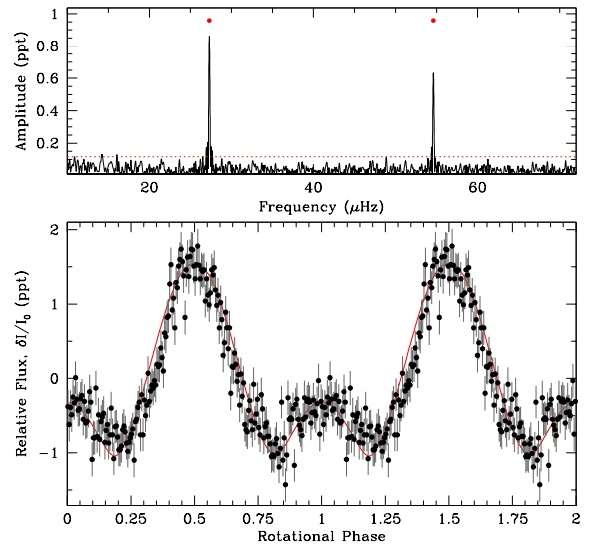December 30, 2016 report
Pulsations detected in a hot, helium-atmosphere white dwarf

(Phys.org)—Astronomers have recently discovered non-radial oscillations in a hot, helium-atmosphere white dwarf designated PG 0112+104. The newly detected 11 independent pulsation modes in this white dwarf could be essential for researchers testing the radial differential rotation and internal compositional stratification of highly evolved stellar remnants. The findings were presented in a paper published Dec. 22 on the arXiv pre-print server.
PG 0112+104 was first identified as a helium-atmosphere (DB) white dwarf with a mass of about 0.5 solar masses and an effective temperature of over 30,000 K. Now, a team of astronomers led by J. J. Hermes of the University of North Carolina has found that its luminosity varies due to non-radial pulsations that resulted in reclassification of this star to a variable DB white dwarf (DBV).
The researchers used NASA's Kepler space telescope in order to find pulsations of PG 0112+104. The white dwarf was observed for nearly three months in mid-2016 during Campaign 8 of Kepler's prolonged mission known as K2.
"We present the detection of non-radial oscillations in a hot, helium-atmosphere white dwarf using 78.7 d of nearly uninterrupted photometry from the Kepler space telescope," the scientists wrote in the paper.
Thanks to Kepler, the team detected 11 independent pulsation modes, the majority of which have solid mode identifications and corroborate the surface rotation period. The observational campaign allowed them to distinguish five low-order dipole modes and three quadrupole modes, all of which show rotationally split multiplets and probe the internal rotation at different depths.
The researchers added that the amplitude of the newly identified pulsations is so low that previous observations were simply not sensitive enough to detect this variability. Therefore, detecting such pulsations in white dwarfs may be not so easy, especially when using ground-based observatories.
"The relatively low-amplitude pulsations observed in PG 0112+104 demonstrate that many white dwarfs that have been observed not to pulsate, mostly from the ground, may indeed vary but at amplitudes below historical detection limits," the paper reads.
According to the paper, the astronomers have also spotted a clear photometric signature of the surface rotation rate likely caused by a spot rotating into and out of view. They noted that PG 0112+104 is the first pulsating white dwarf known with a photometric signal corresponding to the surface rotation period. The surface rotation rate was estimated to be 10.17 hours.
"We speculate that this photometric signal is caused by redistributed flux from the ultraviolet by an opacity source localized on the surface, perhaps by a weak magnetic field," the team wrote.
The authors of the paper emphasize the importance of rotation of stars for our understanding of stellar evolution. They note that it affects physical processes such as convection, diffusion, and the dynamos generating strong magnetic fields. Thus, the surface rotation rate of PG 0112+104 and its pulsations could be important to advance our knowledge on this matter. Thus, the researchers plan to conduct more detailed analysis of this white dwarf in the future.
More information: A deep test of radial differential rotation in a helium-atmosphere white dwarf: I. Discovery of pulsations in PG 0112+104, arXiv:1612.07807 [astro-ph.SR] arxiv.org/abs/1612.07807
Abstract
We present the detection of non-radial oscillations in a hot, helium-atmosphere white dwarf using 78.7 d of nearly uninterrupted photometry from the Kepler space telescope. With an effective temperature >30,000 K, PG 0112+104 becomes the hottest helium-atmosphere white dwarf known to pulsate. The rich oscillation spectrum of low-order g-modes includes clear patterns of rotational splittings from consecutive sequences of dipole and quadrupole modes, which can be used to probe the rotation rate with depth in this highly evolved stellar remnant. We also measure a surface rotation rate of 10.17404 hr from an apparent spot modulation in the K2 data. With two independent measures of rotation, PG 0112+104 provides a remarkable test of asteroseismic inference.
© 2016 Phys.org





















